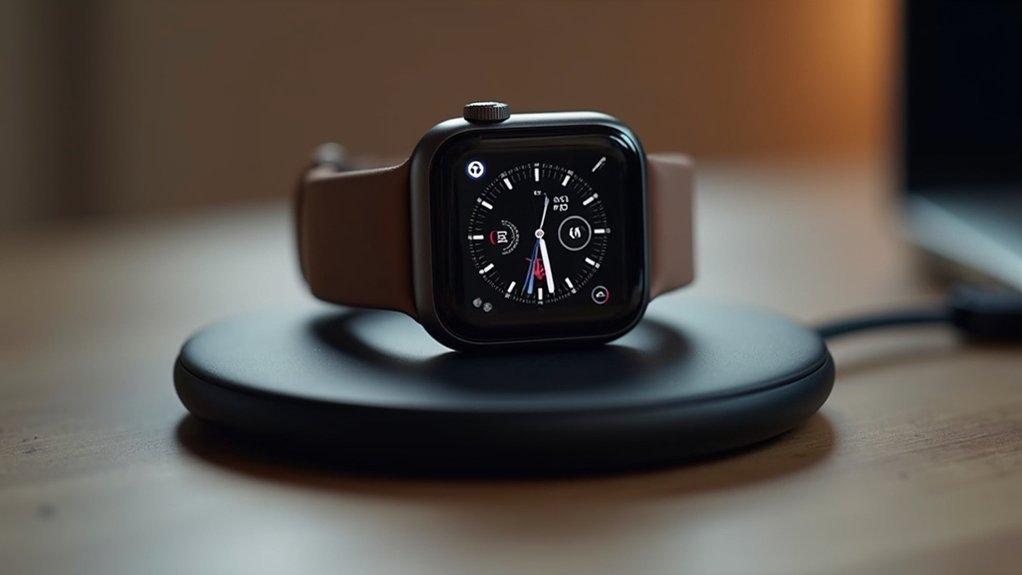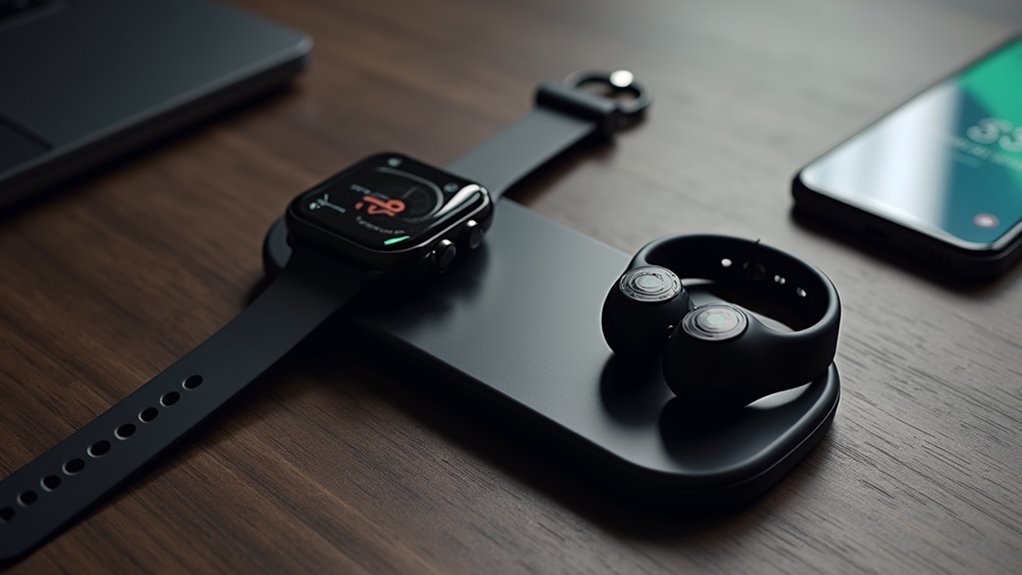The three best wireless charging wearables worth investing in are the Apple Watch Ultra 2 with its impressive 36-hour battery life, Samsung Galaxy Watch with Qi compatibility, and Fitbit Sense with convenient dock charging. You’ll appreciate the cable-free convenience, especially with multi-device charging stations that can power your phone and watch simultaneously. While charging speeds may be slower than wired options, the convenience factor makes these devices particularly valuable for your daily routine. Discover how the upcoming Qi2 protocol will transform your charging experience.
Apple Watch Ultra 2: Wireless Charging Performance and Battery Life

Adventurers seeking extended battery life will find the Apple Watch Ultra 2 impressive with its substantial 564mAh battery that delivers up to 36 hours of regular use.
With proper management, you’ll enjoy two to three days between charges, perfect for extended outdoor excursions.
Experience multi-day power freedom—ideal for wilderness treks without hunting for outlets between adventures.
When it’s time to power up, the included USB-C Magnetic Fast Charging Cable paired with a 20W adapter will reach 80% in about an hour.
For maximum charging efficiency, avoid extreme temperatures and minimize display use during charging. The Ultra 2’s robust titanium case provides excellent protection against impacts during active charging scenarios.
While the Ultra 2 excels in water activities and offers thorough workout tracking, remember that features like Emergency SOS and Oceanic+ require connectivity or subscriptions.
This balance of durability, battery longevity, and fast charging makes it ideal for both adventure enthusiasts and everyday users.
Multi-Device Charging Stations: Convenience vs. Charging Speed
When organizing your charging ecosystem, multi-device charging stations present a compelling solution that balances convenience with inevitable speed tradeoffs.
These stations utilize 5-coil arrays to eliminate dead zones, though they typically cap at 10W per device—slower than dedicated 15W single-device pads.
You’ll enjoy the single-cable management and non-slip surfaces that keep your devices securely aligned, especially in shared spaces.
Premium models like the CATCH:2 ($100-$150) feature Italian leather and aluminum construction, while modular options allow expansion to charge up to six devices. The CATCH:2 features high-grade aluminum alloy paired with pebble-grain Italian leather for a luxurious look and feel.
Consider your priorities: speed or convenience? If you need to charge multiple devices overnight, the slower charging won’t matter.
For daytime quick-charges, you might prefer separate high-speed options, particularly for devices like the Apple Watch Ultra 2.
Qi2 Protocol: The Future of Faster Wireless Charging for Wearables
The landscape of wireless charging is advancing beyond today’s multi-device stations toward a more efficient future. The emerging Qi2 protocol, utilizing Magnetic Power Profile technology, promises to revolutionize how your wearables charge.
With perfect alignment through magnetic coupling, Qi2 eliminates positioning frustrations while delivering up to 15W of power—significantly faster than current standards. You’ll waste less energy and reduce the need for charging cables, creating less electronic waste.
Though adoption remains limited primarily to iPhone 12+ devices and select Android phones like the HMD Skyline, the protocol’s future looks promising. Look for the distinctive Qi2 logo on packaging to identify compatible products.
As Samsung’s upcoming Galaxy S25 reportedly embraces Qi2, the standard could soon expand to wearables, offering cross-platform compatibility and improved charging efficiency for your favorite gadgets.
Frequently Asked Questions
Can Wireless Charging Damage My Wearable’s Battery Over Time?
Yes, wireless charging can slightly damage your wearable’s battery over time due to excess heat generation. However, modern devices include temperature sensors that help mitigate this risk by adjusting power output when needed.
Are Wireless Chargers Safe to Use Overnight?
Yes, wireless chargers are generally safe overnight. Modern devices have automatic shutoff mechanisms, but you’ll maximize battery health by using certified chargers, ensuring proper ventilation, and avoiding constant 100% charging cycles when possible.
Will My Wearable Charge Through a Protective Case?
Yes, your wearable will charge through a protective case if it’s thin (under 3mm) and made from compatible materials like silicone or TPU. Avoid metal cases or thick plastic that can block the charging signal.
How Much Energy Do Wireless Chargers Consume When Idle?
Wireless chargers consume 0.2-0.5W when idle as they continuously draw power to detect devices. You’ll add about 1.75kWh yearly to your energy bill if you leave one plugged in constantly without using it.
Can Wireless Charging Wearables Be Used While Swimming?
Yes, you can use wireless charging wearables while swimming if they have IP68 or ATM 5+ waterproof ratings. However, you can’t charge them underwater—the wireless charging function only works when the device is dry.
In Summary
Wireless charging brings convenience to your wearable experience, though with some trade-offs. The Apple Watch Ultra 2 delivers solid battery life despite slower charging, while multi-device stations save space but compromise on speed. As Qi2 technology becomes more widespread, you’ll enjoy faster charging and better efficiency. Until then, weigh your priorities—convenience or charging speed—when deciding if wireless charging wearables are worth your investment.





Leave a Reply